Friday and Saturday: May 24-25
Segovia, Madrid and Home
Today we woke to our last day in Segovia. We enjoyed our last breakfast at the Hotel La Casa Mudéjar then it was back to the room to pack up.
After checking out we walked down to the bus station. We had a 9:00 departure for Madrid which would get us there in time to meet Jeff for a little walk about and some food.

This van was parked not far from the bus station so I grabbed a shot. They look like lamb carcasses. Check out the clever logo on the front door- a combination of the aqueduct and a sheep's head.
Our bus ride to Madrid was uneventful. Once we arrived at the Estación Príncipe Pío we caught the #10 line to the Plaza de Castilla station. We then walked the rest of the way to Jeff and Ana's.
_02.jpg)
The Plaza de Castilla
The Puerta de Europa Towers are at the north end of the Plaza. The Caja Madrid Obelisk is erected directly in the center of the plaza.
When we arrived, Jeff was home and was ready to take us out for a walk and some eats.

Our walk took us by Casa Pepe. They are known for their wings and justifiably so. Tasty! I had to rassle Betsy for the last one.

Then it was on up the street a ways to El Pinchito II for some more tasty treats. Here, Betsy guards the aperitivo/pincho.
A pincho (Spanish:literally "thorn" or "spike") or pintxo (Basque) is a snack, typically eaten in bars, traditional in northern Spain and especially popular in the Basque country. They are usually eaten in bars or taverns as a small snack while hanging out with friends or relatives; thus, they have a strong socializing component, and in the Basque country they are usually regarded as a cornerstone of local culture and society.
They are related to tapas, the main difference being that pinchos are usually 'spiked' with a skewer or toothpick, often to a piece of bread. They are served in individual portions and always ordered and paid for independently from the drinks. It is not impossible, however, to have the same item called "pincho" in one place and "tapa" in other.They're called pinchos because many of them have a pincho (Spanish for spike), typically a toothpick —or a skewer for the larger varieties— through them. They should not be confused with brochettes, which in Latin America are called pinchos too; in brochettes, the skewer or toothpick is needed in order to cook the food or keep it together.
Source: WikiPedia
Here is a bit more information from Dr Jeffrey Bruner:
Pinchos aren't necessarily skewered. Like cañas, there's no official rule about what a pincho is versus what a tapa is, so you'll find the two terms used rather indiscriminately. What I can add is then when you order a beer, you will usually get an "aperitivo" (like the olives or the salchichón in the pic), whereas you will typically pay for pinchos/tapas. But not everywhere. Confusing?
As Jeff mentioned to me before, "Food vocabulary is complicated". Indeed!

We had ordered a shrimp dinner but they were out so Jeff ordered Salpicón de Marisco "Seafood Surprise".
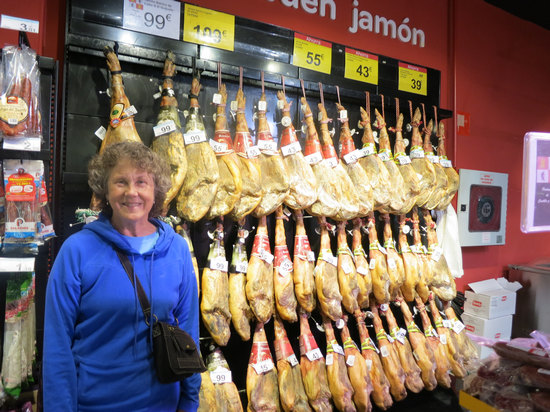
After we got back to the house, Betsy and I went around the corner to the mercado for some snacks and beer. They had a nice selection of jamón. As I looked them over I started to wonder if I could squeeze one into my duffel bag. Later I mentioned this to Jeff and he informed me that was called smuggling. I had not quite thought of it in those terms before.

This tree was outside the entrance to Jeff and Ana's place. Jeff asked me what it was. I do not know. Do you? If so, please drop me a line. I am pretty sure it is not a fig (Ficus). But the genus has 600 species, so I guess it is possible.
"NOTE: Rhody devote Sandra recognized the tree and identified it as Loquat (Eriobotrya japonica). In Spanish it's "Níspero".
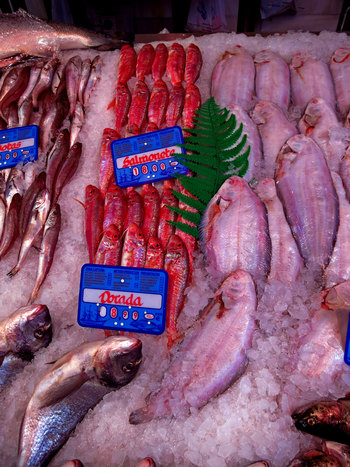
Later on that day we joined the family for the weekly shopping. All the seafood! Amazing.
Here is an interesting tid-bit Betsy told me. Before we arrived in Spain we spent a week in the Scottish Highlands. Most of the open areas there are covered in thick stands of Bracken Fern (Pteridium aquilinum). Betsy was told by one of the rangers the dried bracken fronds were used for mattress stuffing and also for packing fish when it was crated. No doubt this was a practice in Spain as well. And, in keeping with the tradition, this fish monger had plastic ferns laid about on the fish.
I found a reference to this use of ferns for fish packing in Ireland and as far away as Australia.
After fishing all night the catch was brought in, and all hands were needed to pack the fish in boxes lined with bracken fern and ice.
Source: © COPYRIGHT 2005 - 2013 Creative House Publications Pty Ltd

Decisions, decisions!
Boy, would it be fun to try each and every one.

Even though I adjusted the white balance on my camera, the mix of tungsten and fluorescent light wreaked havoc with the results.
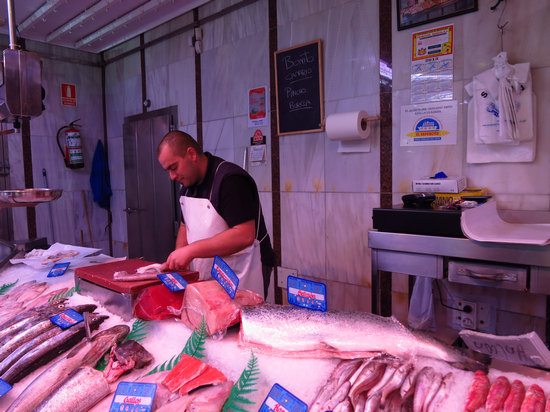
Every order is handled personally and custom prepared according to the customer's needs. That's what I call service!
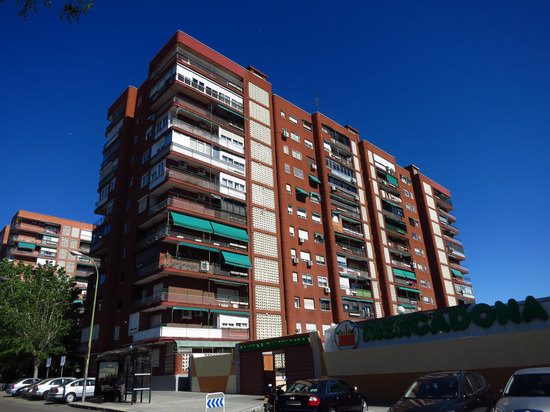
This is a look at one of the high rise buildings in Jeff and Ana's barrio. That's a lot of bricks! The low wall on the right with the open door is the access to the Super Mercado. Handy.

Later that day we took a bus to a nearby Metro station.
Betsy is pushing Guillermo and Ani is hidden behind her.
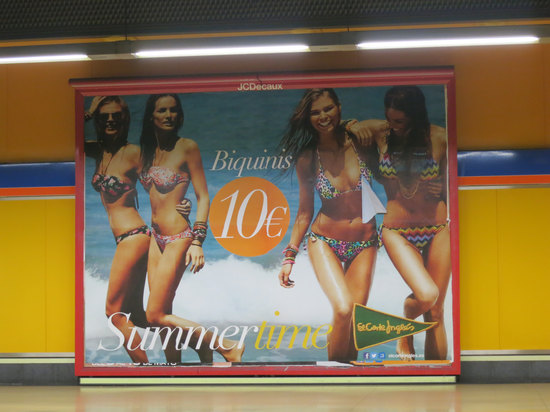
This ad was at every Metro stop landing. Ahh... summer time!

Here we are on the Metro with Jeff, Ana and Guillermo.
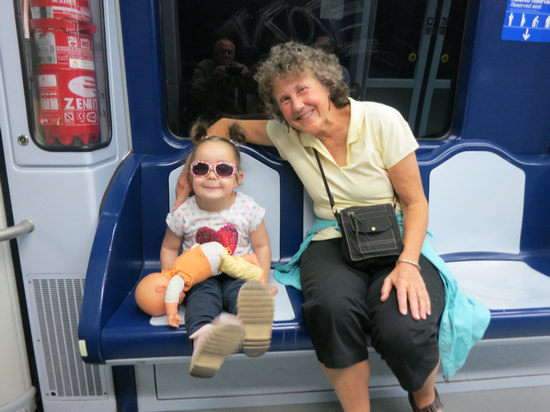
Ani and Betsy - two cuties!
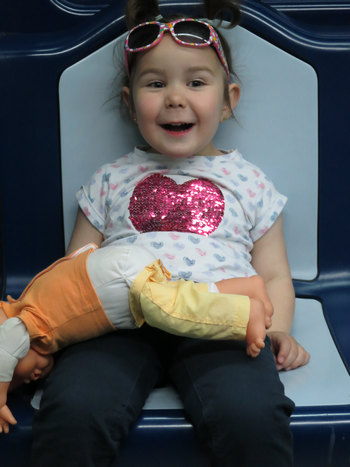
My, oh, my how Ani has grown since I last saw her in September of 2010.
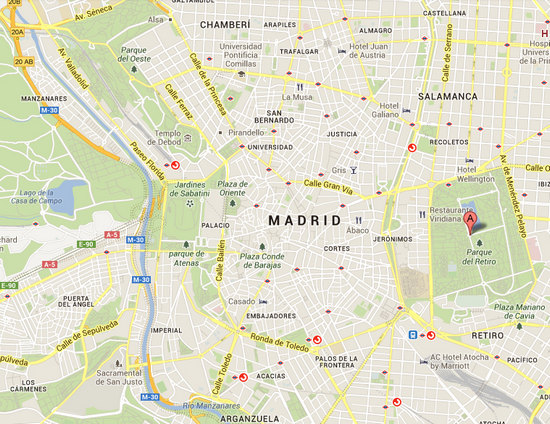
Here is where we are riding the Metro to: Parque del Retiro. It is at the red marker. To the west you can see Jardines de Sabatini which is adjacent to Rosaleda Gardens, the rose garden Betsy and I visited on our first day in Madrid.
Further west is the 6 square mile Casa de Camp which we also visited on our first day in Madrid.
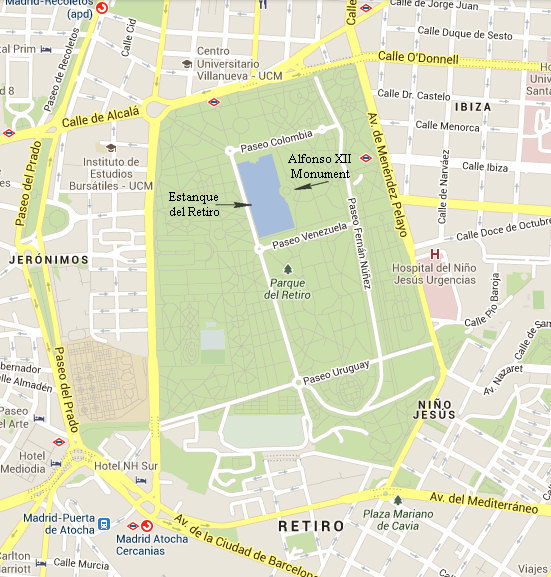
A closer look at Parque del Retiro.
Note the two metro symbols within the boundaries of the park. This will give you an idea of the volume of people visiting the park.
This will give you an idea of the volume of people visiting the park.
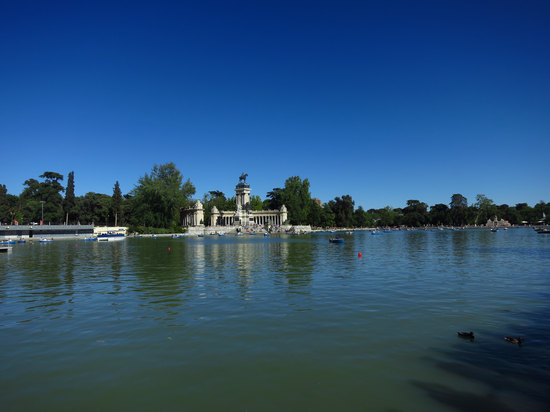
I think it is safe to say the focal point of the park is the 400'x1000' "great pond" - Estanque bel Retiro and the Alfonso XII Monument.
The Count-Duke of Olivares commissioned the park in the 1630s, worked on by Cosimo Lotti, a garden designer who had worked under Bernardo Buontalenti on the layout of the Boboli Gardens for Cosimo I, Grand Duke of Tuscany. Water was a distinguishing trait of the garden from the outset: the great pond, Estanque del Retiro, which served as the setting for mock naval battles and other aquatic displays, the great canal, the narrow channel, the chamfered or bellflower pond, created —along with the chapels— the basic layout of the gardens.
Source: WikiPedia
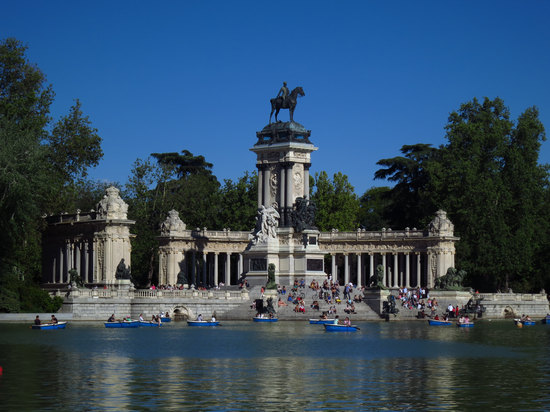
Monument to Alfonso XII
In 1902, a national contest was held to design a monument for King Alfonso XII at the initiative of the Queen Mother Maria Christina of Austria. The winner was the architect José Grases Riera, whose design consisted of a grand colonnade alongside a pond in El Retiro, with several sculptures surrounding an equestrian statue of the king, with everything constructed in bronze and marble.
The monument is 30 meters high, 86 meters long, and 58 meters wide. At its center is the equestrian statue of King Alfonso XII, cast in Bronze, which was created by Benlliure in 1904. In the central base of the monument are the statues "La Paz" ("Peace") by Miquel Blay, "La Libertad" ("Freedom") by Aniceto Marinas and "El Progreso" ("Progress") by Miguel Ángel Trilles.
Source: WikiPedia

The Monument to Alfonso XII and a monument to feminine beauty and grace.
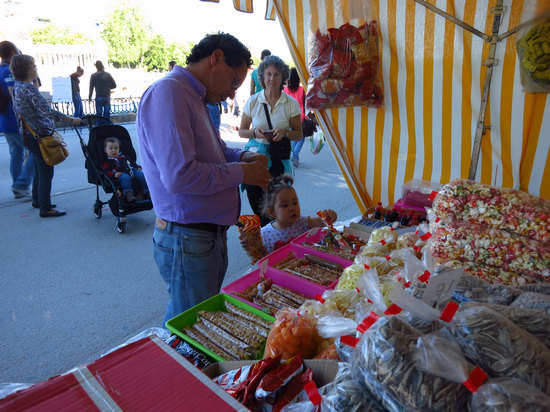
There were lots of snack stands set up which did not go unnoticed by Ani.
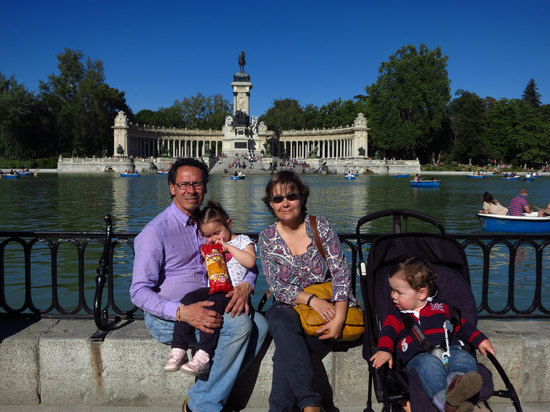
You can sure tell what Ani is interested in!
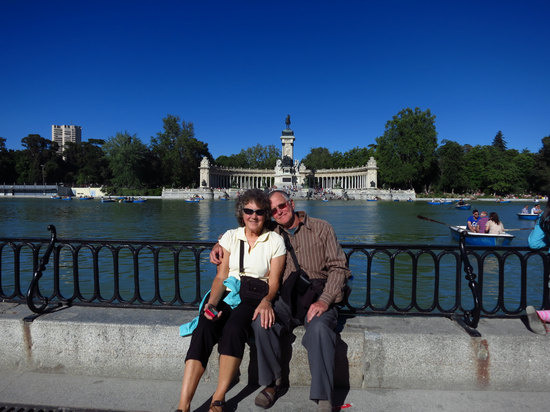
The two weary travellers brace each other up.
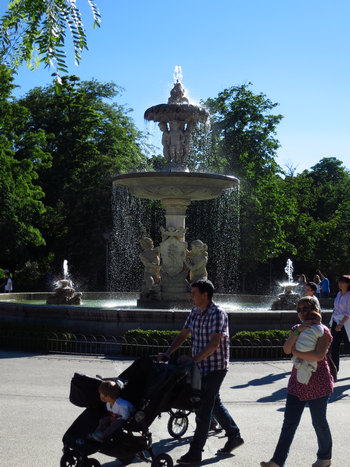
There is much to see in Parque del Retiro. I wish I had taken more photos.

I love this shot.
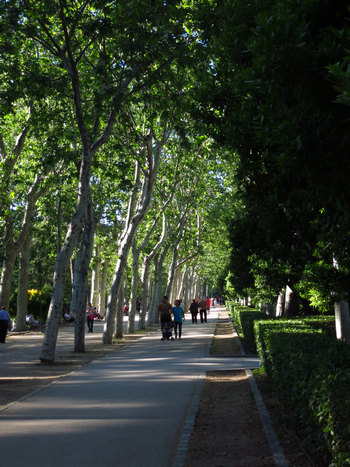
Strolling the promenade. What a wonderful way to spend a weekend afternoon.
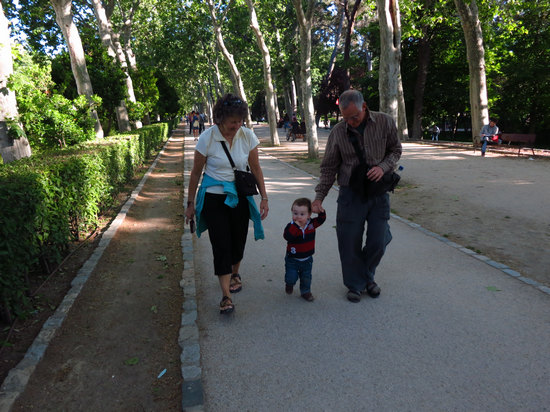
Let me tell you this boy was a handful! Shortly after this was taken, he broke free and bolted. So much to explore, touch, taste...
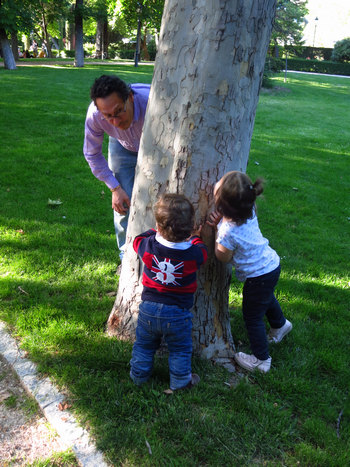
Peek-a-boo!
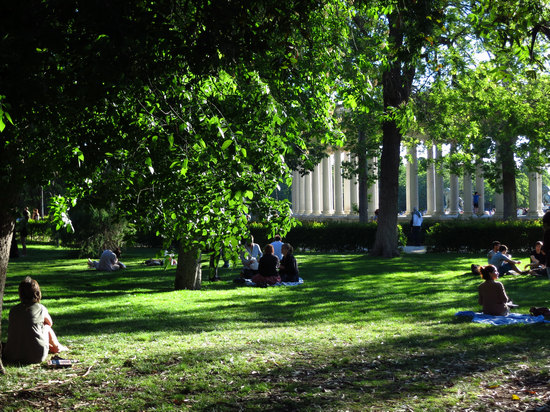
There were many people doing just this - relaxing and enjoying the weather.
And that is my last shot of the day and last shot for this quite wonderful trip.
We returned to Jeff and Ana's via the Metro and then walked back from there. Now it was almost "lunch" time.
Ana prepared some delicious and interesting meals for us. With my brain being foggy and no photos to jog my memory Jeff and Ana put this list together:
Winter gazpacho
Padrón peppers
Morcilla de Burgos
Tortilla de patata con calabacín (zucchini)
Gazpacho (and/or Salmorejo???)
Langostinos
Calamares en su tinta
By far the most memorable meal was the Calamares en su tinta (squid in its ink). Ana had mentioned it was an acquired taste. She is right! Not only do the taste buds need to adjust but so do the eyes.
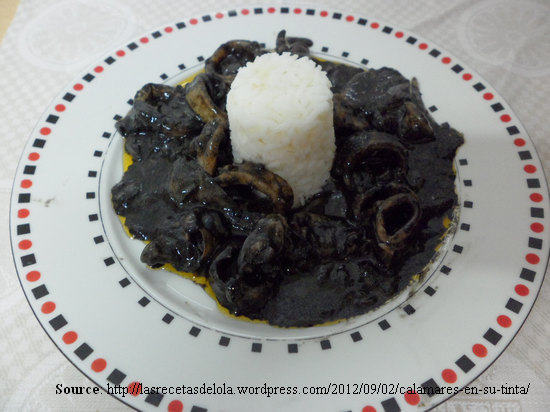
I have to say I have never eaten anything before which looked like this!
I would love to know how many West Virginians have eaten Squid stewed in their own ink! Not too many... But, what would you expect from a land locked place like WV?
The taste? Indescribable. And, I mean that. How does one describe a flavor never before experienced? And then there was the texture. The thick sauce and the "al dente" squid which was actually quite tender. But, still a bit weird to chew.
I enjoyed it. I can't say I ate it with gusto, but I did have two servings. So, that says something.
Betsy did not enjoy it quite as much. The thick, black sauce with little squid tentacles sticking out put her off a bit. Actually, at first it seemed kinda freaky to me! Guess I have watched to many "Alien" type movies.
It was this kind of experience and so many others I am most thankful to Jeff and Ana for. Without their hospitality, knowledge, patience and encouragement the trip would have been a much less memorable experience.
And, so I present a toast to Jeff and Ana and Betsy for a wonderful time. Salud!
Until next time...